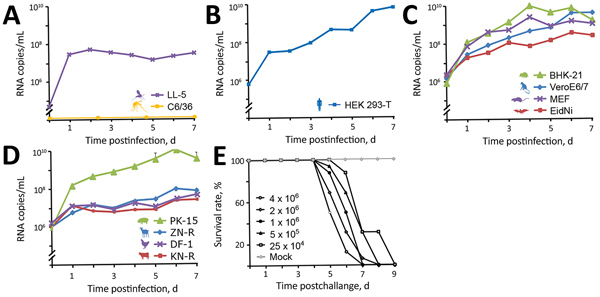Sand Fly–Associated Phlebovirus with Evidence of Neutralizing Antibodies in Humans, Kenya
David P. Tchouassi

, Marco Marklewitz, Edith Chepkorir, Florian Zirkel
1, Sheila B. Agha, Caroline C. Tigoi, Edith Koskei, Christian Drosten, Christian Borgemeister, Baldwyn Torto, Sandra Junglen
2
, and Rosemary Sang
2
Author affiliations: International Centre of Insect Physiology and Ecology, Nairobi, Kenya (D.P. Tchouassi, E. Chepkorir, S.B. Agha, C.C. Tigoi, B. Torto, R. Sang); Charité-Universitätsmedizin Berlin, Berlin, Germany (M. Marklewitz, F. Zirkel, C. Drosten, S. Junglen); German Center for Infection Research, Berlin (M. Marklewitz, F. Zirkel, C. Drosten, S. Junglen); Center for Virus Research, Kenya Medical Research Institute, Nairobi (E. Koskei, R. Sang); University of Bonn, Bonn, Germany (C. Borgemeister)
Main Article
Figure 5

Figure 5. In vitro growth kinetics of novel sand fly–associated phlebovirus Ntepes virus from Kenya in different cell lines. A) Insects: LL-5, sand fly; C6/36, mosquito. B) Human: HEK293-T. C) Peridomestic wildlife: hamster, BHK-21; primate, VeroE6/7; mouse, MEF; bat, EidNi. D) Livestock: swine, PK-15; goat, ZN-R; chicken, DF-1; cattle, KN-R. Cells were infected with a multiplicity of infection of 0.1; supernatants were collected every 24 h for 7 d postinfection. Viral genome copies were measured at indicated timepoints by real-time reverse transcription PCR. E) Pathogenicity of Ntepes virus infection in mice. Litters of 2-day-old Swiss Albino suckling mice (8 mice/litter) were intracerebrally inoculated using the indicated virus titers or cell culture media as a control. Animals were monitored daily for signs of disease. Titers are shown in PFU/mL.
Main Article
Page created: March 17, 2019
Page updated: March 17, 2019
Page reviewed: March 17, 2019
The conclusions, findings, and opinions expressed by authors contributing to this journal do not necessarily reflect the official position of the U.S. Department of Health and Human Services, the Public Health Service, the Centers for Disease Control and Prevention, or the authors' affiliated institutions. Use of trade names is for identification only and does not imply endorsement by any of the groups named above.
